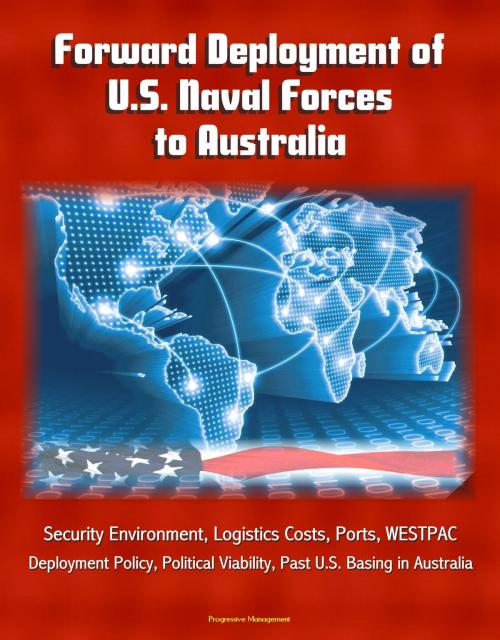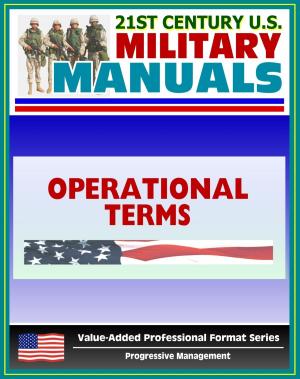Forward Deployment of U.S. Naval Forces to Australia: Security Environment, Logistics Costs, Ports, WESTPAC, Deployment Policy, Political Viability, Past U.S. Basing in Australia
Nonfiction, History, Australia & Oceania, Military, Naval| Author: | Progressive Management | ISBN: | 9781310597381 |
| Publisher: | Progressive Management | Publication: | May 6, 2015 |
| Imprint: | Smashwords Edition | Language: | English |
| Author: | Progressive Management |
| ISBN: | 9781310597381 |
| Publisher: | Progressive Management |
| Publication: | May 6, 2015 |
| Imprint: | Smashwords Edition |
| Language: | English |
Professionally converted for accurate flowing-text e-book format reproduction, this military study looks at the forward deployment of American naval forces to Australia. Per the 2006 Quadrennial Defense Review (QDR), the U.S. Navy intends to increase its presence in the Pacific Ocean. Unfortunately, the size of the Pacific means that U.S-based ships spend a smaller proportion of each deployment available in theater. Forward-Deployed Naval Forces (FDNF) represent an attractive alternative, but current overseas bases cannot easily accommodate more ships. Australia, a strong U.S. ally in the heart of the theater, offers a number of potential advantages including numerous suitable ports, an educated English-speaking population, and the opportunity for strengthening diplomatic ties and military interoperability. Calculations of transit times and distances reveals potential savings in both transit costs and ship constructions (FDNF can "do more with less") that might repay the required initial investment in basing. Other possible benefits of increasing the FDNF footprint include reassurance of regional allies, a counter-balance to growing Chinese influence, and a chilling effect on terrorism, piracy, and drug trafficking. Potential drawbacks include initial investment requirements, an Australian backlash against the alliance, or a perceived threat to Chinese or North Korean interests. Nevertheless, Australia, America, and other Pacific Rim nations might accept, and could benefit from, such basing.
CHAPTER 1 * INTRODUCTION * Thesis * Underlying Assumptions * Security Environment * Deployment Policy * Logistics Costs * Delimitations * Primary and Secondary Research Questions * Feasibility Analysis * Political Viability * Financial Feasibility * Strategic and Operational Considerations * Scope * CHAPTER 2 * LITERATURE REVIEW * Source Material Categories * Military-Academic Works * Surveys and Collections * Historical Background of Australia-U.S. Relationship * Past U.S. Basing in Australia * Websites * Authoritative Primary Source Material * Secondary Source Material * Military Cooperation Challenges * Other Academic Works * Factual References and Analysis Tools * Distance Tools * Cost References * Government Websites and Documents * Military Interoperability * U.S. Strategy * Australian Strategy and the U.S. Relationship * Regional Outlooks and Strategic Considerations * Contrary Views * Works of Particular Topical Relevance * Summary * CHAPTER 3 * RESEARCH METHODOLOGY * Foundations * Analytical Geography * Operational Cost-Benefit Analysis * Strategic Analysis * Historical Foundations and Policy Analysis * Internal-Political Analysis * Military-to-Military Analysis * Geopolitical Analysis * Methodology Limitations and Delimitations * Chapter Conclusions * CHAPTER 4 * ANALYSIS * Foundations * Analytical Geography * Australia and its Maritime Environment * Ports - Draft Considerations * Ports - Environmental and Other Limitations * Human geography * Areas of Responsibility * Western Pacific (WESTPAC), Commander, U.S. Seventh Fleet * Arabian Gulf / Middle East, Commander, U.S. Fifth Fleet. * Other Reference Points * Time-Distance Summary * Geography Conclusions * Cost-Benefit Analysis * Source: 13 March 2007 Statement Of Admiral Robert F. Willard, Vice Chief of Naval Operations, before the House Armed Services Committee Subcommittee on Military Readiness, 13 March 2007, at House website (accessed 20 November 2007) * Response Ratio Calculations * Utilization of Limited Steaming-Day Allotment * Response Ratio and Transit Costs * Compound Efficiencies * Persistent Presence * Financial Conclusions: Meeting the Fleet Commander's Needs * Strategic Considerations * Historical Context
Professionally converted for accurate flowing-text e-book format reproduction, this military study looks at the forward deployment of American naval forces to Australia. Per the 2006 Quadrennial Defense Review (QDR), the U.S. Navy intends to increase its presence in the Pacific Ocean. Unfortunately, the size of the Pacific means that U.S-based ships spend a smaller proportion of each deployment available in theater. Forward-Deployed Naval Forces (FDNF) represent an attractive alternative, but current overseas bases cannot easily accommodate more ships. Australia, a strong U.S. ally in the heart of the theater, offers a number of potential advantages including numerous suitable ports, an educated English-speaking population, and the opportunity for strengthening diplomatic ties and military interoperability. Calculations of transit times and distances reveals potential savings in both transit costs and ship constructions (FDNF can "do more with less") that might repay the required initial investment in basing. Other possible benefits of increasing the FDNF footprint include reassurance of regional allies, a counter-balance to growing Chinese influence, and a chilling effect on terrorism, piracy, and drug trafficking. Potential drawbacks include initial investment requirements, an Australian backlash against the alliance, or a perceived threat to Chinese or North Korean interests. Nevertheless, Australia, America, and other Pacific Rim nations might accept, and could benefit from, such basing.
CHAPTER 1 * INTRODUCTION * Thesis * Underlying Assumptions * Security Environment * Deployment Policy * Logistics Costs * Delimitations * Primary and Secondary Research Questions * Feasibility Analysis * Political Viability * Financial Feasibility * Strategic and Operational Considerations * Scope * CHAPTER 2 * LITERATURE REVIEW * Source Material Categories * Military-Academic Works * Surveys and Collections * Historical Background of Australia-U.S. Relationship * Past U.S. Basing in Australia * Websites * Authoritative Primary Source Material * Secondary Source Material * Military Cooperation Challenges * Other Academic Works * Factual References and Analysis Tools * Distance Tools * Cost References * Government Websites and Documents * Military Interoperability * U.S. Strategy * Australian Strategy and the U.S. Relationship * Regional Outlooks and Strategic Considerations * Contrary Views * Works of Particular Topical Relevance * Summary * CHAPTER 3 * RESEARCH METHODOLOGY * Foundations * Analytical Geography * Operational Cost-Benefit Analysis * Strategic Analysis * Historical Foundations and Policy Analysis * Internal-Political Analysis * Military-to-Military Analysis * Geopolitical Analysis * Methodology Limitations and Delimitations * Chapter Conclusions * CHAPTER 4 * ANALYSIS * Foundations * Analytical Geography * Australia and its Maritime Environment * Ports - Draft Considerations * Ports - Environmental and Other Limitations * Human geography * Areas of Responsibility * Western Pacific (WESTPAC), Commander, U.S. Seventh Fleet * Arabian Gulf / Middle East, Commander, U.S. Fifth Fleet. * Other Reference Points * Time-Distance Summary * Geography Conclusions * Cost-Benefit Analysis * Source: 13 March 2007 Statement Of Admiral Robert F. Willard, Vice Chief of Naval Operations, before the House Armed Services Committee Subcommittee on Military Readiness, 13 March 2007, at House website (accessed 20 November 2007) * Response Ratio Calculations * Utilization of Limited Steaming-Day Allotment * Response Ratio and Transit Costs * Compound Efficiencies * Persistent Presence * Financial Conclusions: Meeting the Fleet Commander's Needs * Strategic Considerations * Historical Context















